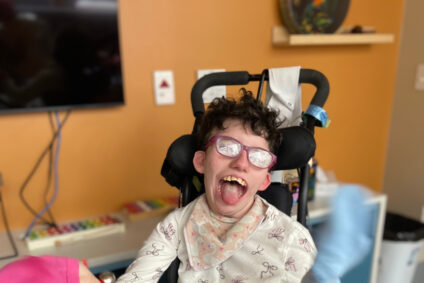Palliative Care: Toronto’s first children’s hospice to open

Emily's House, a project of Philip Aziz Centre, was recently featured in a Toronto Star article. As we all come together to anticipate the opening of Emily's House, read this article to see why we decided it was time for Toronto's first children's residential hospice. To read the article online please click here.
Many thanks to the The Star and Laura Kane for featuring Emily's House and bringing awareness about in Toronto. And many thanks to the Yeskoo family for sharing their story with us all.
![]()
Palliative Care: Toronto's first children's hospice to open
Reporter: Laura Kane
Emily Yeskoo’s smile is unlike any other young woman’s smile.
The 20-year-old’s wide, toothy grin lights up her family’s living room in North York, where she has been bedridden for the past five years of her short life, unable to eat, speak or walk.
“What’s your secret, Emily?” her mother, Lindsey, whispers, as she brushes back her daughter’s hair. “Tell Toronto your secret.”
Emily’s secret is now well-known to many working in pediatric palliative care in the city. Diagnosed with a rare neurodegenerative disease at age 10 and given three years to live, she is, miraculously, still alive.
Her incredible will to live has inspired scores of people to donate more than $5 million — on top of the province’s $2 million — to build the city’s first children’s hospice, finally set to open next month.
Fittingly named Emily’s House, the residential hospice will feature six provincially funded palliative-care beds at first, eventually 10, as well as respite care so that families with terminally ill children can take a badly-needed break.
After eight years of struggling to obtain land and city permits, the hospice will open in the renovated Governor’s House next to the former Don Jail, at 562 Gerrard St. E., complete with a three-story addition built to modern medical standards.
Ironically, Emily is now too old to reside in the hospice, which will care for children up to age 18. But Lindsey says it’s a resource that is long-overdue for mothers like her.
“The demands are impossible and there’s very little time to get the support you need,” she says. “That’s why Emily’s House to me is beautiful.”
Lindsey has cared for Emily at home 24 hours a day, seven days a week, for the past eight years. She sleeps in a bed next to Emily’s and wakes up every hour, on the hour, every night to check on her.
When Emily faces a crisis and has to go to hospital, her mother doesn’t leave her side. If no one brings Lindsey coffee and breakfast in the morning, she doesn’t eat.
“Emily’s House is just such a different kind of place. It is a homelike environment, without the pressures of home,” says Lindsey, who is married with two healthy children — a teenage daughter and a son in his 20s.
“There will be spaces that a mother can go where she can have peace and quiet and collect herself, but know that her child is just a minute away.”
Rauni Salminen, the hospice’s executive director, agrees. She helped model Emily’s House after Canada’s first children’s hospice, Vancouver’s Canuck Place. There are now two others in Ontario — Darling Home for Kids in Milton and Roger’s House in Ottawa — bringing the total to six nationwide.
As Salminen walks through the sunny, brightly painted home, now nearing the end of construction, she gestures to spaces that will make life easier for families. A large open kitchen and living area, for siblings to play. A bed for parents to sleep in next to their child. A “Snoezelen room,” a soothing space filled with stimuli for the child’s various senses.
“We want to be a place about love and life and celebrating each day,” she says. “From music therapy to pet therapy to art therapy, we want to create a place where kids can still be kids.”
The home was launched by the Philip Aziz Centre for Hospice Care, a home palliative-care program that has been supporting Emily for seven years. Inspired by Emily’s fighting spirit, Salminen decided to name the children’s hospice after her.
At the moment, children with terminal diseases in Toronto spend their final days at home or in Sick Kids, says a pediatric palliative care physician at the hospital, Dr. Adam Rapoport.
But he says the hospital is a sterile environment designed to cure children, not necessarily to comfort them as they die. Meanwhile, some parents cannot bear the thought of their child dying at home, he added.
“In the city of Toronto in particular, we are really short of options,” he says. “Emily’s House adds one more option . . . that is in many ways the best of both worlds.”
Palliative care for children differs from palliative care for adults in that young people, like Emily, tend to suffer from rarer diseases and can live for much longer, he adds.
Emily suffers from metachromatic leukodystrophy, an inherited disease caused by both parents having a recessive gene. The disease affects her white brain matter, causing developmental delays, paralysis and impaired swallowing.
She was a bright, healthy girl before age 7, when her physical and mental abilities began to deteriorate. Since her diagnosis, Emily’s had several brushes with death, including at 15 when her body began to reject her feeding tube.
But in recent months — possibly due to a new medically risky feeding tube that delivers nutrients straight to her heart — Emily has shown improvement. For the first time in years, she can swallow and roll over onto her stomach, her mother says.
“This is the amazing thing. Everybody thought they were going to call it Emily’s House, but Emily wouldn’t be here, and there would be that story.
“But actually, people are really inspired by the fact that . . . the impossible is happening, and she is resuming life again. It’s incredibly hopeful for other families.”


